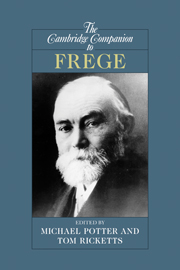Book contents
- Frontmatter
- 1 Introduction
- 2 Understanding Frege’s project
- 3 Frege’s conception of logic
- 4 Dummett’s Frege
- 5 What is a predicate?
- 6 Concepts, objects and the Context Principle
- 7 Sense and reference: the origins and development of the distinction
- 8 On sense and reference: a critical reception
- 9 Frege and semantics
- 10 Frege’s mathematical setting
- 11 Frege and Hilbert
- 12 Frege’s folly: bearerless names and Basic Law V
- 13 Frege and Russell
- 14 Inheriting from Frege: the work of reception, as Wittgenstein did it
- Bibliography
- Index
- Series List
12 - Frege’s folly: bearerless names and Basic Law V
Published online by Cambridge University Press: 28 September 2010
- Frontmatter
- 1 Introduction
- 2 Understanding Frege’s project
- 3 Frege’s conception of logic
- 4 Dummett’s Frege
- 5 What is a predicate?
- 6 Concepts, objects and the Context Principle
- 7 Sense and reference: the origins and development of the distinction
- 8 On sense and reference: a critical reception
- 9 Frege and semantics
- 10 Frege’s mathematical setting
- 11 Frege and Hilbert
- 12 Frege’s folly: bearerless names and Basic Law V
- 13 Frege and Russell
- 14 Inheriting from Frege: the work of reception, as Wittgenstein did it
- Bibliography
- Index
- Series List
Summary
FREGE ON TRUTH
Frege tells us surprisingly little about truth. And some of what little he does say, he repeats:
One can, indeed, say: 'The thought that 5 is a prime number is true'. But closer examination shows that nothing more has been said than in the simple sentence '5 is a prime number'. The truth claim arises in each case from the assertoric sentence, and when the latter lacks the usual force, e.g., in the mouth of an actor upon the stage, even the sentence 'The thought that 5 is a prime number is true' contains only a thought, and indeed the same thought as the simple '5 is a prime number'.
Whereas in the much later 'Thoughts' from 1918 it is sameness of thought/content that is emphasized:
It is also worth noticing that the sentence 'I smell the scent of violets' has just the same content as the sentence 'It is true that I smell the scent of violets'.
in the 1897(?) 'Logic' we find the emphasis is on assertion:
If I assert that the sum of 2 and 3 is 5, then I thereby assert that it is true that 2 and 3 make 5.
Strictly, the claim about assertion is distinct from that about content (sameness of thought). It could be that it is a fact about assertion, e.g. , that it aims at truth, as people say, that nothing different is accomplished in asserting that the sum of 2 and 3 is 5 and that it is true that the sum of 2 and 3 is 5, rather than a fact about the contents asserted. But this is not Frege’s view. In both ‘On sense and reference’ and ‘Thoughts’ Frege points to a certain redundancy where truth is concerned. For any assertoric sentence p, p and ‘It’s true that p’ have ‘just the same content’ (‘Thoughts’), they ‘contain the same thought’ (‘On sense and reference’).
- Type
- Chapter
- Information
- The Cambridge Companion to Frege , pp. 465 - 508Publisher: Cambridge University PressPrint publication year: 2010
- 2
- Cited by



